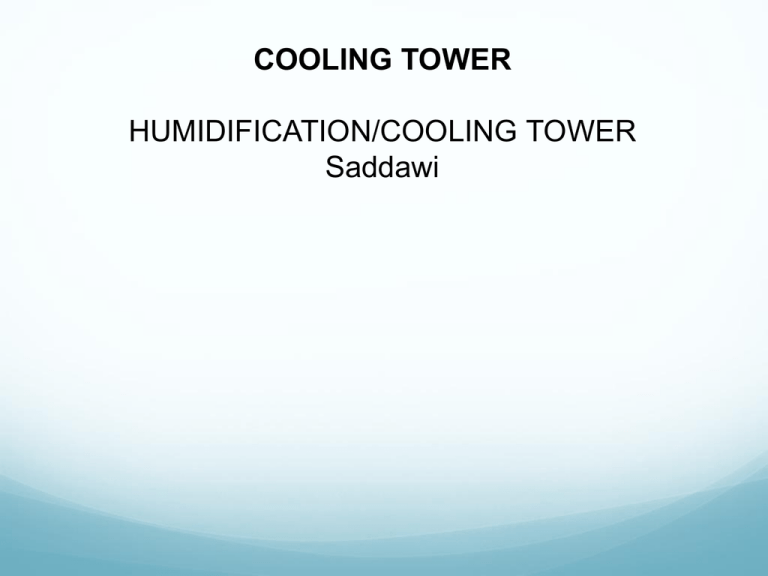Batch Reactor Lecture
advertisement

COOLING TOWER HUMIDIFICATION/COOLING TOWER Saddawi The Goal of the Experiment The goal of this experiment is to determine heat and mas balance for countercurrent air-water system in a Packed Cooling Tower. To find the Characteristic equation, Number of Transfer Units NtoG and Number of Heights Transfer Units HtoG Murphree gas phase stage efficiency and the Overall cooling tower effectiveness efficiency Experimental Setup Base unit components include: 1. Air distribution chamber. 2. A tank with heaters to simulate cooling loads of 0.5, 1.0 and 1.5kW. 3. A makeup tank with gauge mark and float operated control valve. 4. A centrifugal fan with intake damper to give 0.06kg s-1 max. air flow. 5. A water collecting basin. 6. An electrical panel Note Use distilled water to fill the makeup tank . Monitor and record the amount of water evaporated during all of the test operations of the cooling tower. This can be done by measuring the time needs to spend by added amount of water to the make-up tank. Check wet bulb thermocouple reservoir for water. Add if necessary. After the system reach to study sate, Record all temperatures, dry and wet bulb temperatures of the air and water temperature of all sections, mass flow-rate of ware and air. Some background theory The basic function of a cooling tower is to cool water by intimately mixing it with air. This cooling is accomplished by a combination of: Sensible heat transfer between the air and the water (Conduction and Convection) and it controlled by temperature differences and area of the contact between air and water. And the evaporation of a small portion of the water. In the cooling towers, the evaporation is the most effective part in the cooling process Mass Balance and Enthalpy Balance on Cooling Tower *Please see page 12 equations (1,2,&3) Take mass balance over a differential section (see the fig.) mw - mw1 = ma (Y -Y1' ) dmw = ma dY Water Inlet (1) T2 H2 mw Air outlet t2 h2 ma (2) 2 *Mass velocity of dry air remain constant through the cooling tower Take enthalpy balance over the same differential section mw H + mah1' = mw1' H1' + mah dz z 1’ (3) *Because the latent heat of water is a big value, so a small amount of water evaporation will produce large cooling effect. Therefor we can assume the mass velocity of the water falling down through the tower is constant with out large consequences error Please see equation (4) on page 12 mw (H - H1' ) = ma (h1' - h) (4) 1 Water Outlet T1 H1 mw t1 h1 ma Air Inlet Equation (4) can be rewritten in term of heat balance as in equation (5) mwCpw dT = ma dh Where m a Dh = ma (Cpair dt + l3dY ) (5) Take the integral of eq (5) over entire Column mwCpw (T2 -T1 ) = ma (h2 - h1 ) (6) Eq (6) represent Air Bulk Operating Line by plotting air enthalpies versus water temperatures. mw Cpw ma Enthalpy of Air Slope of (NO) line = h2 h1 O N T1 Cooling Tower Operating line (Air bulk operating line) Water Temperature T2 Saturated Air Operating line Saturated Air water vapor Film If you assume that the drops of water falling through the tower are surrounding by a thin air film, * This film must be saturated with water vapor. * The heat and mass transfer take place between the film and the upstream air bulk Where there is no resistance to heat flow in the interface between the saturated air film and water. In other words, the interface temperature can be assumed to be equal to the bulk water temperature (Merkel assumption) T(wart temperature) ≈ ti (interface temperature) Water bulk at temp T Heat movement By plotting the enthalpies of the saturated air–water vapor mixture (film) and water bulk temperatures will produce a curve, please see the Figure. This carve represent Saturated Air Operating line or can be called Water Operating line Air bulk at temp t The relation between the temperature and enthalpy of the saturated air Enthalpy H2 This curve applies to the air film surrounding the water It called Water Operating Line And limited for hot and cold water temp (T2 and T1) Air Operating Line or Tower Operating Line Represent Air condition through the column H3 h2 H1 h3 h1 T1 T3 T2 Water Temperature Driving Force Diagram Enthalpy Driving Force H2-h2 Cooling Range T2-T1 Mass Balance and Enthalpy balance on Cooling Tower In terms of mass and heat transfer coefficients. *Please see page 15-19 mwCpw dT = ma dh Where m a dh = ma (Cpait dt + lw dY ) (5) ma dh = hg a(ti - t)dz + lw K y a(Yi -Y )dz By rearrange eq 7 pleas see eq 11&12 on page 17 Kya dh = dz (H i - h) ma h2 Take integral over entire Tower (7) ò h1 K ya dh = (H i - h) ma z ò dz = o (8) K y az ma (9) h2 ò h1 K ya dh = (H i - h) ma K y az Z ò dz = m = H o a toG z NtoG = Number of Air Enthalpy Transfer Units HtoG = Heights of Transfer Units ma H toG = Kya By combing eqs (5 &9) Merkel’s Equation T2 KaV dT = Cpw ò mw T1 H w - ha H w - ha = Dhm This equation is commonly referred to as the Merkel equation. The left-hand side of this equation is called the ”Tower Characteristic,” which basically indicates the 'degree of difficulty to cool' the water or the 'performance demand' of the tower. The tower characteristic and the cooling process can be explained on a Psychrometric Chart KaV Cpw (T2 - T1 ) = mw Dhm Please note that V=Z =Volume occupied by packing per unit plan area To obtain mean driving force (∆hm) Carey and Williamson method can be used. This depends upon the application of correction factor f to the observed value of Hm- h3 (at the arithmetic mean of inlet and out let water temps T1 & T2) g1 = H1 - h1 g 2 = H 2 - h2 g m = H 3 - h3 Dhm = f g m Characteristic Cooling Tower Equation KaV mw By ploting values of versus mw ma KaV mw n = b[ ] mw ma The cooling tower effectiveness .ε. is defined as the ratio of the actual energy transfer to the maximum possible energy transfer h2 - h1 e= H 2 - h1 Murphree gas phase stage efficiency Y2 -Y1 EMG = Yas -Y1 Yas Y2 Y1 tas t2 t1 Air Temps







